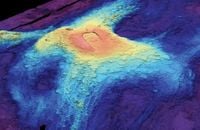Scientists are closely monitoring the Axial Seamount, an active underwater volcano located about 300 miles west of the Oregon coast, as it shows signs of potential eruption for the first time since 2015. Recent data indicates that the volcano, which lies nearly a mile beneath the surface of the Pacific Ocean, is exhibiting increased volcanic activity, with more than 1,000 daily earthquakes recorded at the site.
According to NBC News, the Axial Seamount sits on the Juan de Fuca Ridge, a tectonic boundary where the Juan de Fuca and Pacific Plates are slowly pulling apart. This underwater volcano has been under constant surveillance due to its location and the dense array of sensors installed as part of the Ocean Observatories Initiative. Bill Chadwick, a volcanologist and research professor at Oregon State University, noted that the volcano's inflation is a significant indicator of impending eruptions. “They tend to inflate like a balloon in between eruptions. At Axial, the sea floor is actually rising, and that’s a big signal,” he explained.
The last major eruption of the Axial Seamount occurred in 2015, resulting in an extraordinary lava flow that measured 450 feet thick, which Chadwick compared to two-thirds the height of the Space Needle in Seattle. This massive outpouring of magma was a dramatic event, but it posed no direct threat to human life due to the volcano's depth and remote location. Chadwick stated, “Even if you were out on a boat right over the seamount when it’s erupting, you probably would never know it.”
As of early May 2025, the Axial Seamount is more inflated than it was before previous eruptions in 1998, 2011, and 2015, indicating that magma is rapidly accumulating beneath the seafloor. Swarms of small earthquakes, which are typical precursors to volcanic eruptions, have increased in frequency, leading scientists to suggest that an eruption may occur as soon as tomorrow, May 11, 2025.
Despite the potential for an eruption, experts emphasize that the event is unlikely to have catastrophic consequences for coastal communities. The volcano's location, 4,626 feet below sea level, means that any eruption would primarily consist of slow-moving lava flows on the seafloor, which are not expected to generate tsunamis or other hazards that could impact the coastlines of Oregon, Washington, or California.
However, the Pacific Northwest's extensive fishing industry and undersea cable networks could be affected if hydrothermal activity alters the ocean floor or water chemistry in the region. Communities and vessels operating in deep-sea zones are advised to remain vigilant and stay informed about any seismic updates.
Scientists view this situation as a rare opportunity for research. With the Axial Seamount's real-time monitoring network, researchers can observe a submarine eruption as it happens, which would be a first in many respects. This unique situation helps refine prediction models for not just seafloor volcanoes, but also for terrestrial ones. Chadwick remarked, “On land, if you make a forecast that a volcano is going to erupt in a week or a month and you're wrong, you've cost people a lot of money and time and worry. But we don't have to worry about that at Axial Seamount because these eruptions don't impact anyone. So it's a nice way to test our models, test our forecast and hold ourselves accountable, but without the same repercussions as with volcanoes on land.”
As the scientific community prepares for the possibility of an eruption, they remain focused on the data being collected. The monitoring of the Axial Seamount is crucial not only for understanding its volcanic behavior but also for better predicting the behavior of similar underwater volcanoes globally. The increased seismic activity and inflation of the volcano serve as a reminder of the dynamic geological processes occurring beneath the ocean's surface.
Looking ahead, scientists will continue to track developments at the Axial Seamount closely. The data collected during this period will be invaluable for future research and could help inform safety protocols for coastal communities. While the immediate threat remains low, the potential for an eruption highlights the importance of ongoing research and monitoring of underwater volcanoes.
In summary, the Axial Seamount is poised for a possible eruption, with scientists on high alert due to increased seismic activity. While the eruption may not pose a direct threat to coastal populations, it offers a unique opportunity for research and understanding of volcanic processes.

